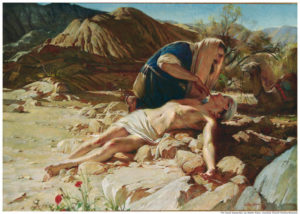Many of the reviews of the Broadway’s The Book of Mormon Musical claim it is only an attack on blind faith. The suggestion is, then, that the missionaries in the musical were operating on blind faith and that perhaps the converts were as well.
 The musical features two young Mormon missionaries, one who wishes he’d been sent somewhere more fun and the other who knows nothing about his religion and so spends his time preaching Star Wars and Lord of the Rings. This is, of course, hardly a realistic portrayal of the typical Mormon missionary. Missionaries generally love being sent out of the country and the more unusual the place, the better. In addition, they are extremely well-educated in their faith.
The musical features two young Mormon missionaries, one who wishes he’d been sent somewhere more fun and the other who knows nothing about his religion and so spends his time preaching Star Wars and Lord of the Rings. This is, of course, hardly a realistic portrayal of the typical Mormon missionary. Missionaries generally love being sent out of the country and the more unusual the place, the better. In addition, they are extremely well-educated in their faith.
Blind faith suggests basing faith on nothing at all. This is not what the truly converted Mormon does. First, by the time a missionary leaves for his mission at age nineteen, he knows far more than the average American teenager knows about his or her own faith. A recent Pew Forum study showed that Mormon teens were among the very few who could intelligently discuss their beliefs and were more likely to live it. Even a cursory review of Mormon teen life would have shown the composers that if they want ignorant missionaries, the Mormons aren’t the place to look for them.
Mormon children begin their religious educations in the home as infants. Their families hold daily scripture study and family prayer. In addition, they have a weekly Family Home Evening, which includes a lesson a gospel principle. In most homes, family members take turns teaching, in addition to rotating the other responsibilities in the home. In this way, young children learn how to teach their beliefs—which is one reason they can intelligently discuss them—and to lead meetings, conduct music, and plan activities. They learn the leadership skills necessary to become good missionaries.
When they are just eighteen months old, they begin to attend the nursery class. Although it is for toddlers and there is ample time to play, they also have lessons and spiritual singing times. They attend the regular worship service with their parents and attend their class during the two classes held afterwards. At age three, they start to attend regular classes and are also invited to prepare and give brief sermons, called talks, in the children’s program. Again, this helps them learn and discuss their beliefs. From ages eight to twelve, they attend a children’s group two to four times a month.
Teenagers get a far more extensive program of education. They give at least one sermon a year, lasting about five minutes, to the entire congregation and sometimes teach classes to their peers as well. Besides attending Sunday School and a class for young men or young women on gospel living, they also have a weekly activity where they put what they’ve learned into practice. They have regular service projects, youth conferences, and religious camps.
Beginning in high school, teens attend a class that is both spiritual and academic in nature on the scriptures. In this class they learn the scriptures in great depth, since it is held almost every school day, usually very early in the morning. The four year program devotes two years to the Bible, one to the Book of Mormon, and one to church history and modern revelations. They are required to read each of these books of scripture as part of this program, the weeknight program, and Sunday School. Since the classes are not all on the same book at the same time, they usually have several books to read at once.
While they are in college, they attend a similar program that is even more rigorous, both spiritually and academically. Most missionaries will have had several years of this program, known as Institute of Religion, behind them before they begin their missions.
As you can see, between home, church, and personal study, a Mormon missionary leaves for his mission with a great deal of education in his faith. Of course, there is more to faith than just knowledge, but knowledge is important. Mormons do not believe in blind faith. Children and converts are expected to learn the beliefs of their faith prior to baptism, which cannot happen earlier than age eight. While they may have only a rudimentary knowledge at this time, they are expected to continue to study and learn.
Next comes testimony. A testimony of God, of Jesus Christ, and of the Savior’s church is a requirement for baptism. Even children are taught to pray for a testimony. They beginning saying simple prayers with a parent’s help as soon as they can talk, but as they get older, they learn how to make prayer a personal conversation with God and to ask for and to receive answers. It is a lack of understanding of faith that makes The Book of Mormon Musical an extremely inaccurate portrayal of Christianity in general. Most Christians do not operate on blind faith.
A Mormon bases his faith on knowledge gained in a personal way. We all know we believe most strongly in things we have personally proven and this is the way with religion. There are some who say we need a physical proof in order to justify believing, but of course, proof is not faith and God teaches that faith what we were sent here to earth to learn. And yet, while we may not have put our hands on specific objects or seen God in person, we can still know what is true.
A Christian does not believe in the Bible because he saw the original papyrus on which it was written or because he personally watched the author at work. He might find scientific proof of the Bible’s authenticity interesting, but it isn’t the basis of his faith. If there were not lions found in the places and times the Bible says there were lions, a Christian knows it is not that they weren’t there, but that we haven’t found the proof yet. Science makes new discoveries every day and today, many things scientists once said weren’t true have been proven true. Christians are patient people in their faith.
Mormons, who also use the Bible, exercise this same faith in the Book of Mormon as well. They don’t need to see the plates on which the Book of Mormon was written any more than they need to see the papyrus on which the Bible was written. They enjoy seeing that archaeologists have, in modern times, discovered ancient records recorded on metal plates, even though they said, in Joseph Smith’s time they never were. However, that isn’t why they believe. They believed before scientists made that discovery.
Everyone knows things that they have never proven scientifically. We live by and believe in many scientific facts without bothering to recreate the experiments for ourselves. We believe in love even though we don’t head for a laboratory to find out if we really are in love. We believe in democracy without a scientific proof that it is the best form of government. We choose our parenting methods based on instincts and preference. We live our lives using faith in things we cannot or choose not to scientifically prove.
And yet, Mormons believe they can prove the existence of God and the truthfulness of their religion. They can’t prove it to anyone else because faith must be individually proven. This proof comes from the Holy Ghost. A person must first have a desire to believe and a basic understanding of what he is about to pray for. Then he takes it to God, because while man is imperfect and might mislead, God never will lead us astray. A testimony based only on material proof can be destroyed when science makes a new discovery that contradicts the old beliefs. The testimony of man can become shaky when we see that person’s imperfection or hear something we didn’t want to believe. When the testimony comes from God, however, there is no question that it is true.
Dallin H. Oaks, a Mormon apostle of Jesus Christ, offered this explanation of why faith is not blind faith:
“In closing, I refer to the relationship between obedience and knowledge. Members who have a testimony and who act upon it under the direction of their Church leaders are sometimes accused of blind obedience.
Of course, we have leaders, and of course, we are subject to their decisions and directions in the operation of the Church and in the performance of needed priesthood ordinances. But when it comes to learning and knowing the truth of the gospel—our personal testimonies—we each have a direct relationship with God, our Eternal Father, and His Son, Jesus Christ, through the powerful witness of the Holy Ghost. This is what our critics fail to understand. It puzzles them that we can be united in following our leaders and yet independent in knowing for ourselves.
Perhaps the puzzle some feel can be explained by the reality that each of us has two different channels to God. We have a channel of governance through our prophet and other leaders. This channel, which has to do with doctrine, ordinances, and commandments, results in obedience. We also have a channel of personal testimony, which is direct to God. This has to do with His existence, our relationship to Him, and the truth of His restored gospel. This channel results in knowledge. These two channels are mutually reinforcing: knowledge encourages obedience (see Deuteronomy 5:27; Moses 5:11), and obedience enhances knowledge (see John 7:17; D&C 93:1).
We all act upon or give obedience to knowledge. Whether in science or religion, our obedience is not blind when we act upon knowledge suited to the subject of our action. A scientist receives and acts upon a trusted certification of the content or conditions of a particular experiment. In matters of religion, a believer’s source of knowledge is spiritual, but the principle is the same. In the case of Latter-day Saints, when the Holy Ghost gives our souls a witness of the truth of the restored gospel and the calling of a modern prophet, our choice to follow those teachings is not blind obedience.” (See Dallin H. Oaks, “Testimony”, Ensign, April 2008 General Conference.)
About Terrie Lynn Bittner
The late Terrie Lynn Bittner—beloved wife, mother, grandmother, and friend—was the author of two homeschooling books and numerous articles, including several that appeared in Latter-day Saint magazines. She became a member of the Church at the age of 17 and began sharing her faith online in 1992.





